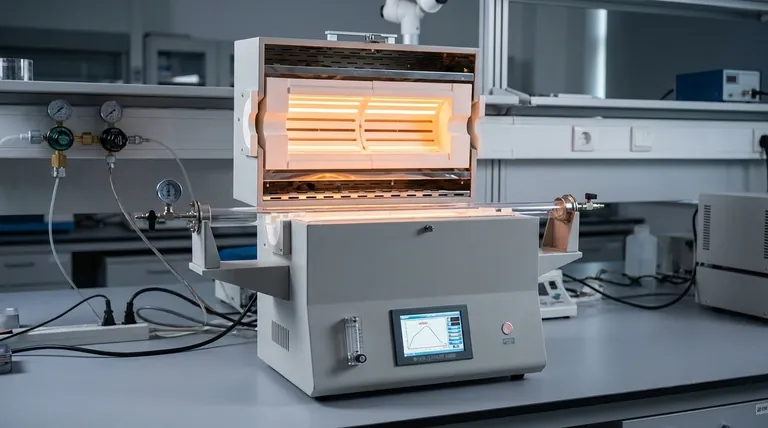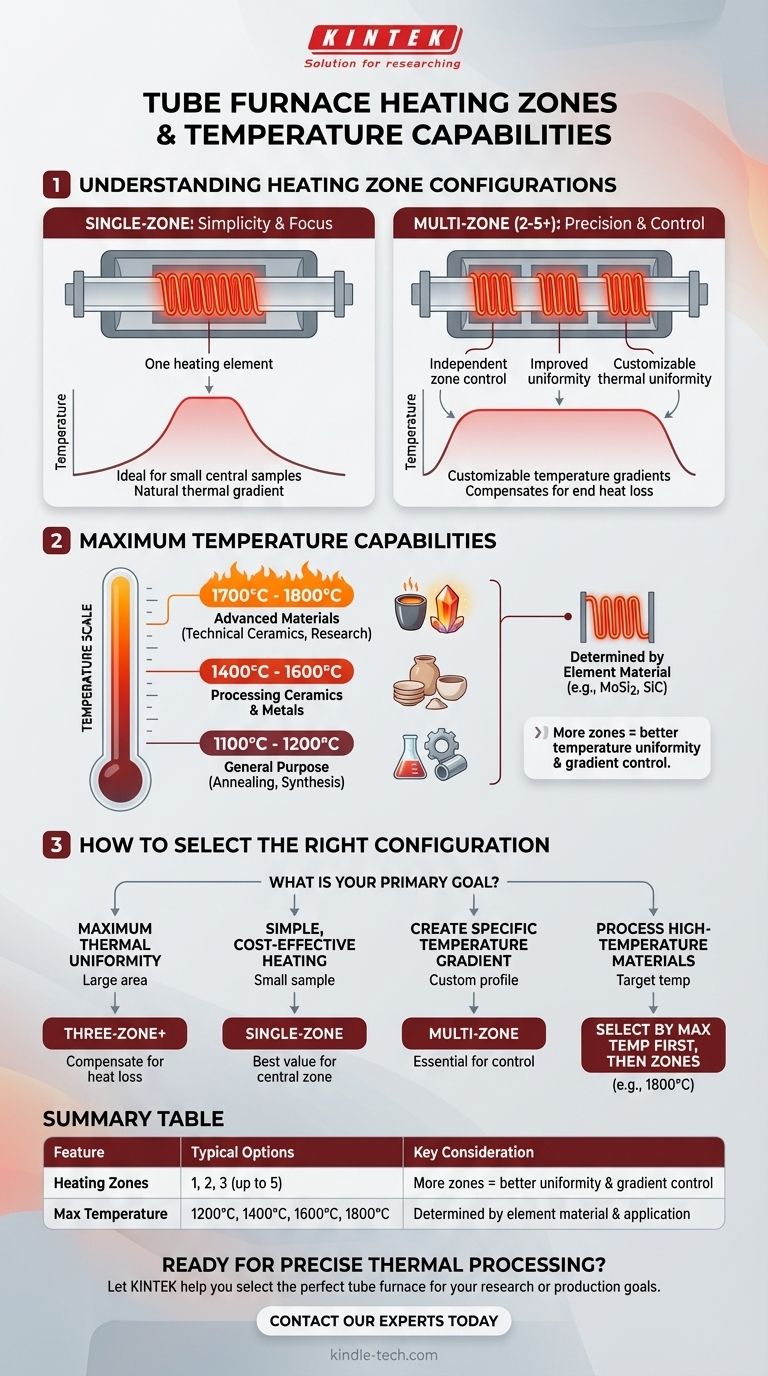To be precise, tube furnaces typically feature configurations with one, two, or three heating zones, though models with up to five zones are available for highly specialized applications. The maximum achievable temperature for these furnaces commonly extends up to 1800°C, with standard models available in ranges like 1200°C, 1400°C, and 1600°C to suit different material processing needs.
The choice of a tube furnace isn't just about hitting a maximum temperature. The critical decision lies in selecting the right number of heating zones, which directly determines your level of control over the temperature profile and uniformity along the tube's length.

Understanding Heating Zone Configurations
The number of heating zones is the most significant factor in a tube furnace's ability to create a specific thermal environment. Each zone is independently controlled, allowing for precise temperature management.
The Single-Zone Furnace: Simplicity and Focus
A single-zone furnace has one heating element that creates a hot zone in the central portion of the tube. The temperature naturally drops off towards the ends of the tube, creating a thermal gradient.
This design is ideal for heating small samples placed directly in the center, where temperature uniformity is highest. For improved uniformity in a compact format, they can be paired with water-cooled end caps to sharpen the transition from hot to cold.
The Multi-Zone Furnace: Precision and Control
Furnaces with two, three, or more zones offer granular control over the temperature profile along the length of the tube. Each zone can be set to a different temperature.
This capability is crucial for two primary goals. First, it can compensate for heat loss at the ends of the tube, creating a much larger and more uniform hot zone. Second, it allows for the intentional creation of specific temperature gradients for processes like crystal growth or chemical vapor deposition.
Maximum Temperature Capabilities
The required operating temperature is dictated entirely by the material you are processing. Furnace manufacturers offer models tailored to common material science thresholds.
Common Temperature Tiers
Tube furnaces are typically categorized by their maximum sustainable temperature. Common tiers include:
- 1100°C - 1200°C: Suitable for many general-purpose heat treatments, annealing, and synthesis applications.
- 1400°C - 1600°C: Required for processing a wider range of ceramics and metals.
- 1700°C - 1800°C: Reserved for advanced technical ceramics and specialized high-temperature materials research.
Heating Element Materials
The maximum temperature is determined by the material of the heating elements. Molybdenum disilicide (MoSi2) or silicon carbide (SiC) elements are often used to reach temperatures up to 1800°C, while more common metallic elements serve the lower temperature ranges.
Understanding the Trade-offs: Single vs. Multi-Zone
Choosing the right configuration requires balancing performance needs with practical constraints.
Cost and Complexity
A single-zone furnace is inherently simpler, making it more cost-effective and easier to operate. As the number of zones increases, so do the cost and the complexity of the control system.
Thermal Uniformity
If your goal is to heat a long sample or multiple samples to the exact same temperature, a multi-zone furnace is superior. By setting the end zones to a slightly higher temperature, you can counteract natural heat loss and achieve excellent thermal uniformity across a significant length of the tube.
Gradient Control
A single-zone furnace can only produce one uncontrolled thermal gradient. A multi-zone furnace is the only choice for creating custom, stable, and repeatable temperature gradients, which is a requirement for many advanced materials synthesis and testing procedures.
How to Select the Right Configuration
Your specific application dictates the ideal furnace. Use your primary goal as the guiding principle for your selection.
- If your primary focus is maximum thermal uniformity over a large area: A three-zone (or more) furnace is the correct choice to compensate for end-zone heat loss.
- If your primary focus is simple, cost-effective heating of a small sample: A single-zone furnace offers the best value and simplicity for placing samples in the uniform central hot zone.
- If your primary focus is creating a specific temperature gradient: You must use a multi-zone furnace to achieve the necessary profile control.
- If your primary focus is processing high-temperature materials: First, select a model rated for your target temperature (e.g., 1800°C), and then decide on the zone configuration based on your uniformity requirements.
Ultimately, choosing the right furnace configuration begins with a clear definition of your thermal processing objective.
Summary Table:
| Feature | Typical Options | Key Consideration |
|---|---|---|
| Heating Zones | 1, 2, 3 (up to 5 for specialized use) | More zones = better temperature uniformity & gradient control |
| Max Temperature | 1200°C, 1400°C, 1600°C, 1800°C | Determined by heating element material & application requirements |
Ready to achieve precise thermal processing? Let KINTEK help you select the perfect tube furnace. We specialize in lab equipment and consumables, offering expert guidance to match the right heating zone configuration and temperature capability to your specific research or production goals. Contact our experts today for a personalized solution!
Visual Guide

Related Products
- 1400℃ Laboratory Quartz Tube Furnace with Alumina Tube Tubular Furnace
- 1700℃ Laboratory Quartz Tube Furnace with Alumina Tube Tubular Furnace
- Multi Zone Laboratory Quartz Tube Furnace Tubular Furnace
- High Pressure Laboratory Vacuum Tube Furnace Quartz Tubular Furnace
- Rotary Tube Furnace Split Multi Heating Zone Rotating Tube Furnace
People Also Ask
- How to clean a tube furnace? A Step-by-Step Guide for Safe and Effective Maintenance
- What is the high temperature of a tube furnace? Unlock the Right Model for Your Application
- What material are furnace tubes? Choosing the Right Material for High-Temperature Success
- What are the benefits of a tube furnace? Achieve Superior Temperature & Atmosphere Control
- What is a tube furnace used for? Achieve Precise, Controlled Thermal Processing



















